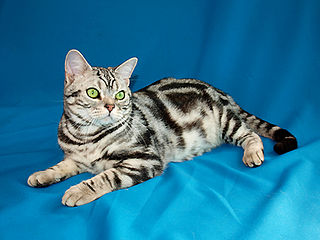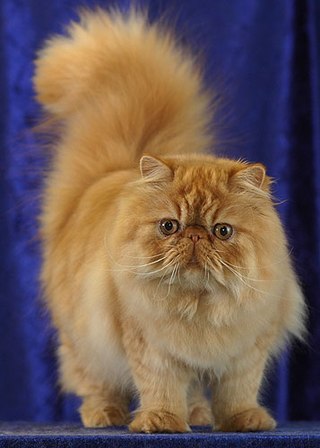
The cephalic index or cranial index is a number obtained by taking the maximum width of the head of an organism, multiplying it by 100 and then dividing it by their maximum length. The index was once used to categorize human beings in the first half of the 20th century, but today it is used to categorize dogs and cats.

The Bengal cat is a breed of hybrid cat created from crossing of an Asian leopard cat, with domestic cats, especially the spotted Egyptian Mau. It is then usually bred with a breed that demonstrates a friendlier personality, because after breeding a domesticated cat with a wildcat, its friendly personality may not manifest in the kitten. The breed's name derives from the leopard cat's taxonomic name.

The Exotic Shorthair is a breed of cat developed as a short-haired version of the Persian. The Exotic is similar to the Persian in appearance with the exception of the short dense coat.

The Scottish Fold is a distinctive breed of domestic cat characterised by a natural dominant gene mutation associated with osteochondrodysplasia. This genetic anomaly affects cartilage throughout the body, causing the ears to "fold", bending forward and down towards the front of the head. While this trait contributes to the breed's unique appearance, often described as "owl-like", it has negative effects on the cats' welfare.

The Munchkin is a breed of cat characterized by its very short legs, which are caused by genetic mutation. Compared to many other cat breeds, it is a relatively new breed, documented since 1940s and officially recognized in 1991. The Munchkin is considered to be the original breed of dwarf cat.

The Himalayan, is a breed or sub-breed of long-haired cat similar in type to the Persian, with the exception of its blue eyes and its point colouration, which were derived from crossing the Persian with the Siamese. Some registries may classify the Himalayan as a long-haired sub-breed of Siamese, or a colorpoint sub-breed of Persian. The World Cat Federation has merged them with the Colorpoint Shorthair and Javanese into a single breed, the Colorpoint.

The Bulldog is a British breed of dog of mastiff type. It may also be known as the English Bulldog or British Bulldog. It is a medium-sized, muscular dog of around 40–55 lb (18–25 kg). They have large heads with thick folds of skin around the face and shoulders and a relatively flat face with a protruding lower jaw. The breed has significant health issues as a consequence of breeding for its distinctive appearance, including brachycephaly, hip dysplasia, heat sensitivity, and skin infections. Due to concerns about their quality of life, breeding Bulldogs is illegal in Norway and the Netherlands.

The Ragdoll is a breed of cat with a distinct colorpoint coat and blue eyes. Its morphology is large and weighty, and it has a semi-long and silky soft coat. American breeder Ann Baker developed Ragdolls in the 1960s. They are best known for their docile, placid temperament and affectionate nature. The name 'Ragdoll' is derived from the tendency of individuals from the original breeding stock to go limp and relaxed when picked up. The breed is particularly popular in both the United Kingdom and the United States.

The American Shorthair (ASH) is a breed of domestic cat believed to be descended from European cats brought to North America by early settlers to protect valuable cargo from mice and rats. According to the Cat Fanciers' Association, it was the eighth most popular pedigreed cat in the world for 2020.

The Siberian is a centuries-old landrace of domestic cat in Russia, and recently developed as a formal breed with standards promulgated the world over since the late-1980s. Since 2006, the breed is recognised for registry and championship status with all major cat registries.

The French Bulldog is a French breed of companion dog or toy dog. It appeared in Paris in the mid-nineteenth century, apparently the result of cross-breeding of Toy Bulldogs imported from England and local Parisian ratters. It is commonly kept as a pet, and is among the most frequently registered dogs in a number of countries including Australia, the United Kingdom, and the United States. The breed is susceptible to various health issues as a consequence of breeding for their distinctive appearance, especially the brachycephalic face and skin wrinkles.

The Neva Masquerade is a breed or sub-breed of long-haired domestic cat, which originates in Russia. It is the sister breed or colourpoint variant of the Siberian cat, a centuries-old Russian landrace. The colourpoint markings are the result of a colourpoint gene originally found in Siamese cats. The Neva Masquerade is believed to be derived from crossing the Siberian cat with Asian colourpoint cats, such as the Siamese or Thai, or possibly cats related to those, such as the colourpointed Persian cats. Some cat registries may classify the Neva Masquerade as a colourpoint variety or sub-breed of the Siberian cat, while others consider it to be a separate sister breed. Regardless of its classification, all Neva Masquerade cats are selectively bred and pedigreed today in all major cat fancier and breeder organisations under the Siberian (Forest) cat or Neva Masquerade. This means that all Neva Masquerade cats are purebred cats with a formally registered ancestry.
A cat registry or cat breed registry, also known as a cat fancier organization, cattery federation, or cat breeders' association, is an organization that registers domestic cats of many breeds, for exhibition and for breeding lineage tracking purposes. A cat registry stores the pedigrees (genealogies) of cats, cattery names, and other details of cats; studbooks, breed descriptions, and the formal breed standards ; lists of judges qualified to judge at shows run by or affiliated with that registry, and sometimes other information. A cat registry is not the same as a breed club or breed society. Cat registries each have their own rules and usually also organize or license (sanction) cat shows. The show procedures vary widely, and awards won in one registry are not normally recognized by another. Some registries only serve breeders, while others are oriented toward pet owners and provide individual as well as cattery memberships, while yet others are federations only deal with breed clubs or even other registries as intermediaries between the organization and breeders.

A dwarf cat is a domestic cat with dwarfism due to rare genetic mutations causing a disproportionate feline body and significant health problems. Unlike undersized cats of normal proportions, dwarf cats suffer from the genetic mutations osteochondrodysplasia and achondroplasia. These genetic disorders of bone and cartilage are typically manifested as abnormal bone shape, poor growth or lack of growth, bowing of the limbs to the side – front legs are more likely to be affected, and spinal malformations.

The Minskin is a breed of cat derived from intentional cross-breeding between the Munchkin and Burmese cat breeds, with the addition of Sphynx and Devon Rex. It is a mostly-hairless or very short-coated dwarf cat breed, with point coloration at the extremities.

Traditional Persian is one of several names for a group of cats that are considered to be essentially the original breed of Persian cat, before the variety was selectively bred to have extreme features. Other everyday usage names are: Doll Face Persian, Classic Persian, Old Fashioned Persian, Long-nosed Persian, Old-style Longhair, Traditional Longhair and Original Longhair.

The Persian cat, also known as the Persian Longhair, is a long-haired breed of cat characterised by a round face and short muzzle. The first documented ancestors of Persian cats might have been imported into Italy from Khorasan as early as around 1620, however, this has not been proven. Instead, there is stronger evidence for a longhaired cat breed being exported from Afghanistan and Iran from the 19th century onwards. Widely recognised by the North-West European cat fancy since the 19th century, and after World War II by breeders from North America, Australia and New Zealand. Some cat fancier organisations' breed standards subsume the Himalayan and Exotic Shorthair as variants of this breed, while others generally treat them as separate breeds.

















